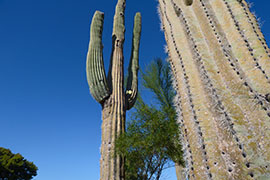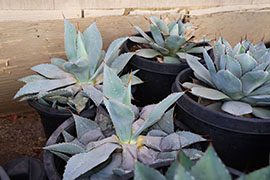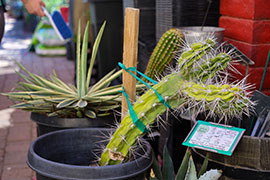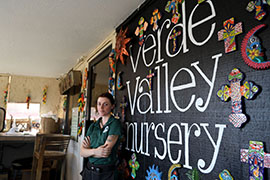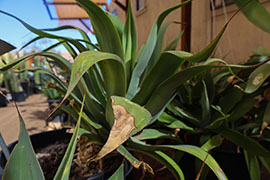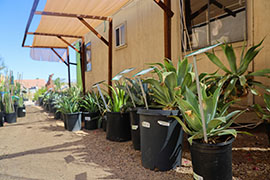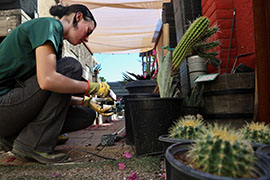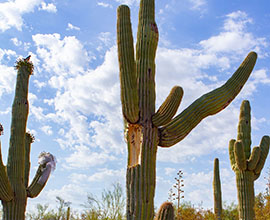- Slug: BC-CNS-Native Plants Heat,1140 words.
- 9 photos, graphic available (thumbnails, captions below).
By Ellie Willard
Cronkite News
PHOENIX – With July being declared Earth’s hottest month on record, Arizonans faced the grim reality of record-breaking temperatures and extreme arid conditions causing residents to seek refuge inside from the relentless heat.
But how did the native dwellers rooted into the desert soil protect themselves?
Native Arizona plants – most notably saguaro cactuses, succulents, palo verde trees and creosote bushes – have adapted over millennia to accommodate the scorching summer highs of the Sonoran Desert, but growing climate change concerns are raising alarms for how well and at what rate these plants will continue to adapt. Experts say cultivating genetic diversity and mitigating Phoenix’s urban heat island must occur to protect native plants.
Seemingly drought-resistant deciduous plants with sunburned or yellowing leaves or those that are dying have worried nurseries, gardens and personal plant collectors this summer.
The summer of 2023 was undoubtedly hot for Phoenix, breaking the city’s record of most days over 110 degrees, but above-average summer temperatures are not new to a desert climate. Summer temperatures in the Sonoran Desert – which ranges from central Arizona to Baja California and Mexico – routinely exceed 104 degrees and often reach 118 degrees, according to the National Park Service.
Although hot temperatures are expected, extreme heat anomalies – like 31 days straight of 110-degree highs – are becoming the norm. Most of the warmest years on record fall within the past two decades, according to data from the National Weather Service.
Chris Martin, a horticulture professor at Arizona State University, said that though Phoenix is located in the Sonoran Desert, it has its own metropolitan ecosystem with streets, buildings and parking lots creating an urban heat-island effect. Surfaces soak up heat during the day, which radiates back at night and makes it harder for the city to cool down.
“Phoenix’s urban heat island is really interesting in that it’s largely a nighttime phenomenon,” Martin said. “We’re setting records of nighttimes that have not gotten below 90 degrees, and that’s been the big issue.”
These persistent scorching temperatures that give no relief overnight contribute to a new environmental effect that native plants have not had time to adapt to.
Kimberlie McCue, chief science officer at the Desert Botanical Garden, echoed the sentiment and said the extreme temperatures coupled with a significantly dry monsoon this year is “way beyond what these plants would have normally experienced.”
One of native plants’ adaptations to help them survive heat and dry conditions is to do part of their photosynthesis process at night. They’ll store water in their pores all day, and when cool nightfall temperatures hit, they will open their pores to take in carbon dioxide to give them sustenance. However, with high overnight temperatures, plants may be losing more carbon and water than they are able to take in, according to McCue and Martin.
“The leaves are yellowing and falling off, plants are dying, they basically are starving to death,” Martin said.
‘Not normal at all’: Native plants show distress
In July, the Desert Botanical Garden had two saguaro cactuses collapse, one large and one small. The emblem of the Arizona desert, the well-adapted and drought-resistant saguaro cactus can live up to 200 years and grow 40-60 feet tall.
Four large saguaros at the gardens also dropped arms within a two-week period.
“That is not normal at all; a healthy saguaro is not going to just drop an arm,” McCue said. “That’s telling us these plants are highly stressed or compromised.”
Trying to find an explanation, McCue’s team looked back at the summer of 2020, which was also a record-breaking year for heat.
“Some saguaros were already compromised from the summer of 2020, and then the summer of 2023 hit them, and it just pushed them over the edge,” McCue said.
She said the Desert Botanical Garden has been getting reports from people in the community that arms on their cactuses are falling off. Agave plants at the garden are also “showing these heightened levels of stress,” which is seen by their yellowing and bending toward the ground.
Kyla Daniel, a sales associate at Verde Valley Nursery in Fountain Hills, said that multiple mesquite trees, elm and oak trees, agave and cactuses have died, and that there were “a lot more deaths this summer than last summer.”
As for the clientele, she said most people are having issues with sunburns on their plants. Overwatering as a way to fix them can harm or kill the plant.
“For most desert native plants, they can get sunburned. And then once they have a little bit of relief, they can start just growing again normally,” Daniel said. “The overwatering is more of an issue than the sunburn is.”
Daniel said she advises a sunshade instead of giving extra water to distressed plants.
Looking to genetic diversity, easing heat island
After thousands of years of evolution, native plants are now struggling under a new wave of environmental conditions, but there is hope that genetic diversity and community efforts can help.
In 2020, teams at the Desert Botanical Garden were deployed outside the urban heat island bubble and into the natural desert landscape to collect seeds from various wild populations of saguaros – some thriving in extremely hot natural temperatures – and planted them back at the garden.
“The key to adapting to changes in an environment is to have genetic diversity within your population,” McCue said. “We’re trying to build resiliency into our population of saguaros.”
Melissa Kruse-Peeples, program coordinator of ASU’s Garden Commons, said in September that as the temperatures began cooling off, she started to see rebounding green growth.
“Desert plants are kind of on a boom-bust cycle. They take advantage when it’s booming and really wet. And so then they can survive the bust times,” Kruse-Peeples said.
This year is predicted to be a wet El Niño year, so Kruse-Peeples said she is hopeful native plants can recover and regrow deeper roots to prepare for what may be another extreme summer.
If extreme summer temperatures return next year, Martin said evolution or change from plants is highly unlikely this soon, but as a community “we’re going to have to implement cultural practices in the short term.” This could include shade protection, a little extra water or a change in the urban plant diversity that favors more heat-tolerant plants. Utilizing the natural desert as an example and trying to keep native plants in their original state can begin to ease the differences between Phoenix and the surrounding desert.
Martin added that Phoenix needs to address the heat-island effect, which would provide native plants with a more stable environment and mitigate heat waves like those in 2020 and 2023.
“I think most if not all of the people that move here, they really start to embrace the specialness that is the desert, and love their saguaros and agaves,” McCue said. “There’s a whole lot of incentive to take care of what we’ve got.”
For more stories from Cronkite News, visit cronkitenews.azpbs.org.
^__=
Two yellowing sunburned cactuses stand at the Desert Canyon Golf Club in Fountain Hills on Oct. 19, 2023. (Photo by Ellie Willard/Cronkite News)
Dragon toes and artichoke agave at Verde Valley Nursery in Fountain Hills struggle with drooping, yellowing leaves on Oct. 19, 2023. (Photo by Ellie Willard/Cronkite News)
A toothpick cactus and Caribbean agave both collapsed from the heat and were put aside at Verde Valley Nursery in Fountain Hills on Oct. 19, 2023. (Photo by Ellie Willard/Cronkite News)
Kyla Daniel, an employee of Verde Valley Nursery for a year and a half, recommends shade for dying or yellowing plants and advises against overwatering. (Photo by Ellie Willard/Cronkite News)
A blue flame agave suffers from sunburned and drooping leaves, leaving the plant vulnerable to continued high temperatures at Verde Valley Nursery in Fountain Hills on Oct. 19, 2023. (Photo by Ellie Willard/Cronkite News)
A row of agaves at Verde Valley Nursery in Fountain Hills suffered from sunburn over the summer and continue to yellow into the fall due to extreme heat in the Valley. (Photo by Ellie Willard/Cronkite News)
Kyla Daniel, a sales associate at Verde Valley Nursery, replants a dying Argentine giant cactus’ pups on Oct. 19, 2023. (Photo by Ellie Willard/Cronkite News)
Seedlings of saguaros obtained from outer desert areas being used for research at the Desert Botanical Garden begin to sprout. (Photo courtesy of Desert Botanical Garden)
A cactus at the Desert Botanical Garden lost a cluster of arms in the peak of July’s heatwave. (Photo courtesy of Desert Botanical Garden)
